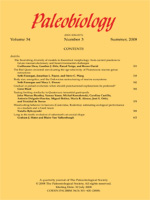Many late Pleistocene fossil localities contain the remains of multiple mammoths. Some of these sites have been interpreted as representing the mass death of an entire herd, or family group, of mammoths. These assemblages have been cited as evidence of intense human predation and used to reconstruct mammoth population dynamics. However, these interpretations remain controversial because the taphonomic settings of many sites are still debated. To reconstruct the taphonomic setting of each site and the movement patterns of mammoths among sites, I used analyses of carbon, oxygen, and strontium isotope ratios in mammoth tooth enamel. The carbon isotopes of fossils vary with diet and local vegetation, oxygen isotopes vary with local climate, and strontium isotopes vary with local soil chemistry. If Pleistocene mammoths traveled together in small family groups, then mammoths from sites that represent family groups should have lower isotopic variability than mammoths from sites containing unrelated individuals. I tested this conjecture by comparing the isotopic variability among mammoths from two sites—one that represents the mass death of a single herd (Waco, Texas) and one representing a time-averaged accumulation (Friesenhahn Cave, Texas)—and then used these analyses to examine mammoths from three Clovis sites: Blackwater Draw, New Mexico; Dent, Colorado; and Miami, Texas. Low levels of carbon isotope variability were found to be the most diagnostic signal of herd/family group association. Although the variability of oxygen and strontium isotope ratios proved less useful for identifying family group assemblages, these signals did provide information about the movement patterns of individuals among different sites. High levels of variability in each of the isotope systems at Clovis sites suggest that all of the sites examined represent time-averaged accumulations of unrelated individuals, rather than the mass deaths of family groups.
In addition, analyses of the mean isotope values of Clovis mammoths show that although most mammoths from Blackwater and Miami had similar values, the values of Dent mammoths were significantly different. This demonstrates that the Dent mammoths belonged to a separate population and suggests that Clovis mammoths did not routinely undertake long distance (≥600 km) migrations.





